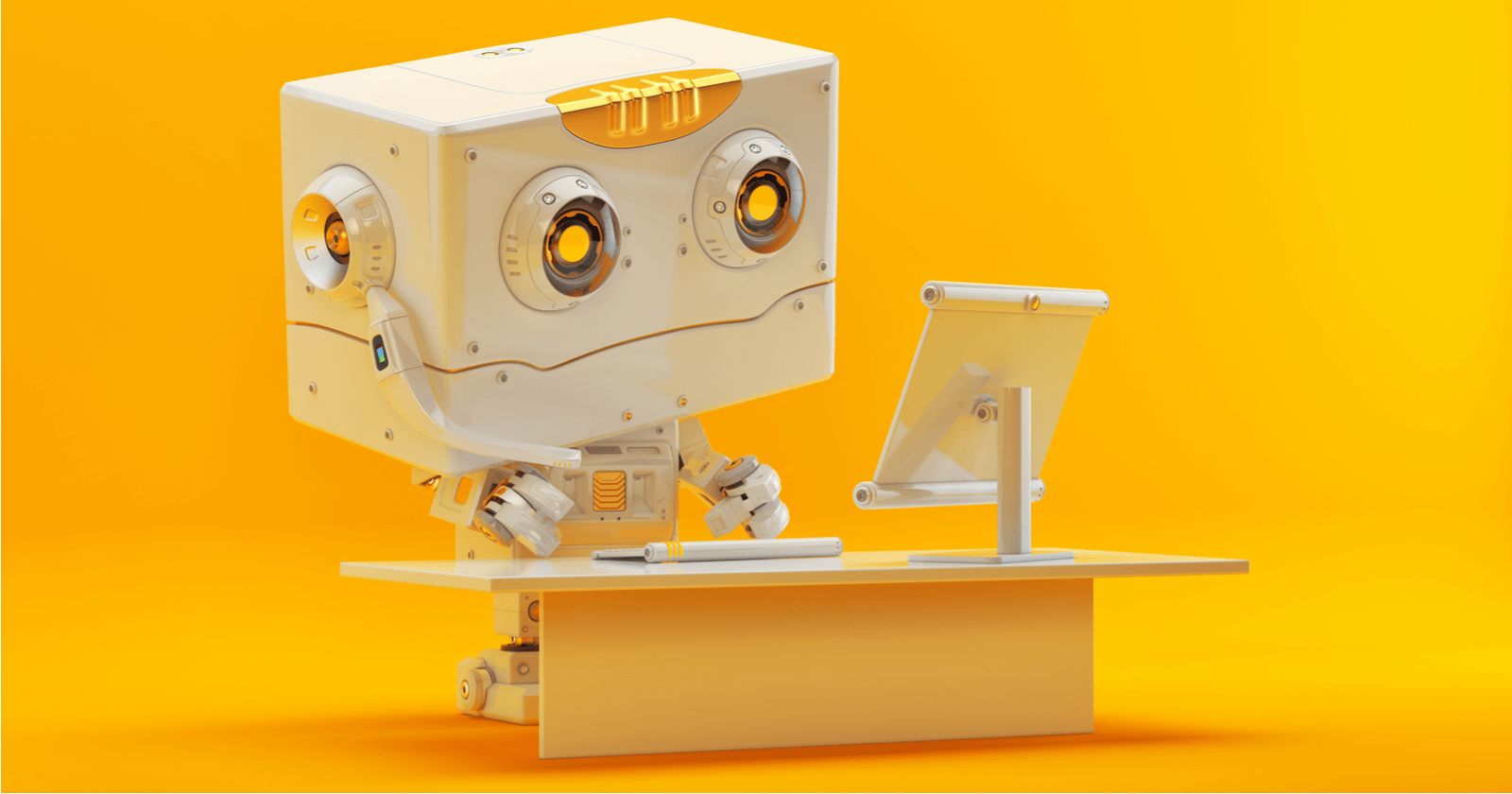Here’s a scary fact that most SEO content creators may not want to face: AI-generated content is already happening.
In 10 years, AI-generated content probably will be the norm.
In 20 years, robot content creators might take over the reins entirely.
Joe Pulizzi, founder of Content Marketing Institute, recently said this very thing:
“In 10 years the majority of content will be generated by software. In 20 years, humans will wonder why we wasted so much time on content creation. I can’t see any other way around this.”

Then again, they might not.
So, if you’re a content creator, should you just give up now? Do we roll over in defeat and cede our work to the bots?
Not quite.
Before we dig deeper into why human writers will remain valuable long past natural language generation (NLG) technology, let’s first examine some of the tech that’s already producing millions and billions of pieces of content.
Ready to meet the robot writers? Let’s start there (and don’t be worried: read the whole post for final thoughts on the state of AI and SEO content creation).
1. Heliograf (The Washington Post)
In 2016, the Washington Post developed our first specimen, Heliograf, in-house to help cover the 2016 Olympics in Rio.
This bot was able to generate short reports for readers that updated them on the outcomes of various games, including medal awards.
According to the publisher, this technology was not developed to replace writers, but rather to help free up their time.
Compiling data-based reports is a mundane, meticulous task. Reporters could otherwise spend that time on providing insights, stories, and analysis “in ways only they can.”
 Examples of short, data-based posts compiled by Heliograf for Twitter
Examples of short, data-based posts compiled by Heliograf for TwitterSince its initial intended use, Heliograf has been put to work for TWP. In 2017, the robot writer created about 850 articles for the publisher, such as updates on high school football games and automated earnings coverage (which it could do with much more accuracy than humans are capable of).
Recently, Heliograf won first place in the 2018 Global BIGGIES Awards in the category “Excellence in Use of Bots.”
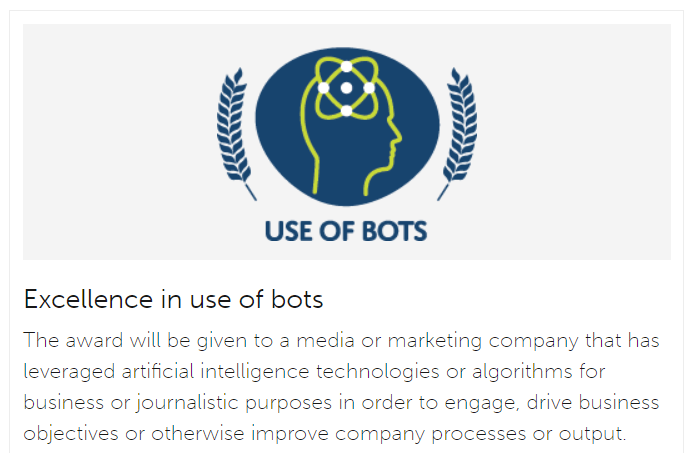
What’s the Cost?
Right now, Heliograf is proprietary software that isn’t available publicly – yet.
2. Quill (Narrative Science)
Next up is Quill, “A.I. that automatically communicates relevant information at scale,” according to the company that distributes it, Narrative Science.
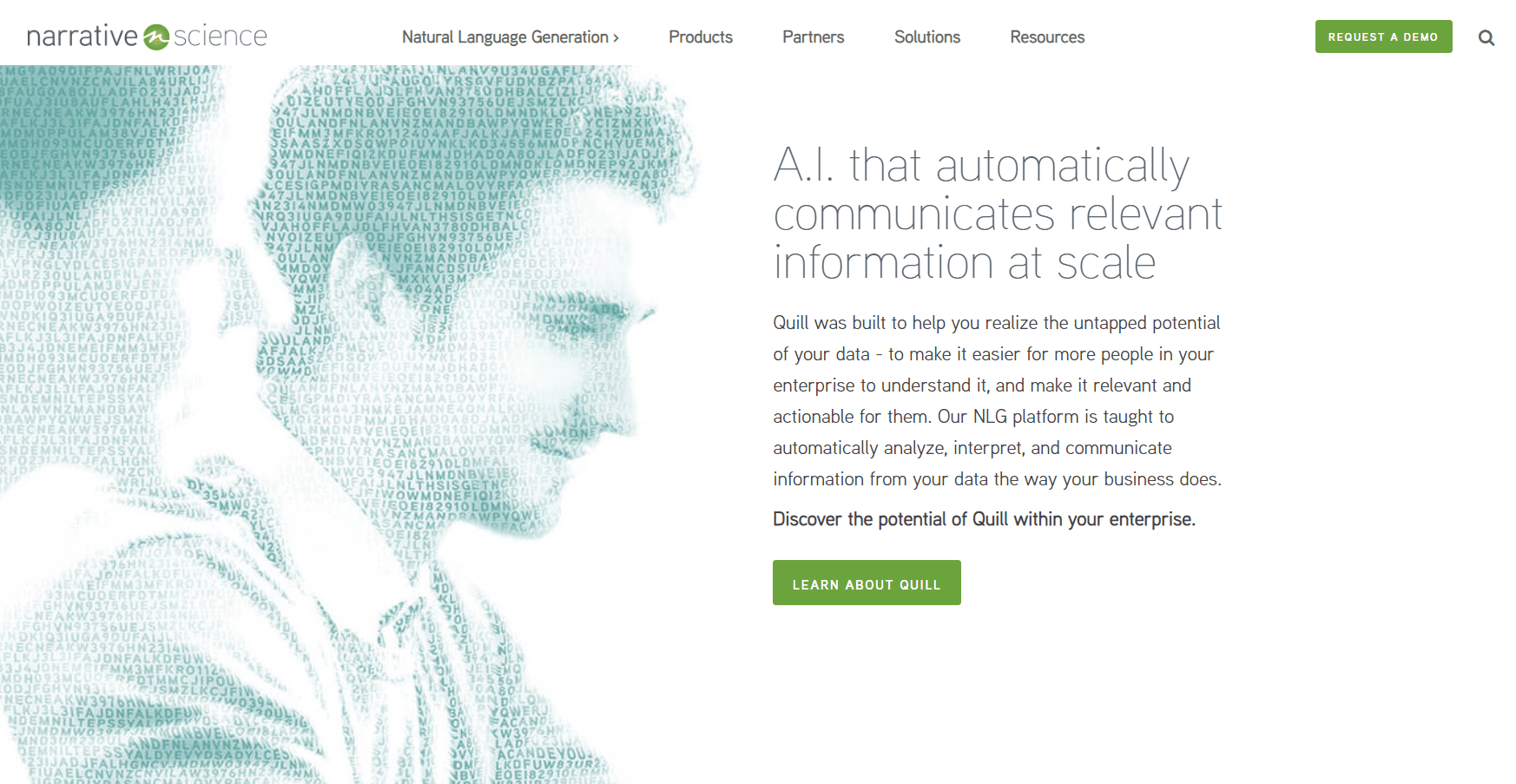
Truly, Quill gives us a good picture of the power and potential NLG technology could have down the road.
According to an interview with one of Quill’s inventors, the software can carry out complex tasks, yet will run on an ordinary PC.
Its biggest feat, however, is the ability to generate relevant, focused, “insightful” narratives from an analysis of machine- or human-compiled data (think spreadsheets to blog posts).
In the same article, the founder of Narrative Science, Kris Hammond, said the technology could easily imitate a sportswriter’s style yet produce 1,000x more articles.
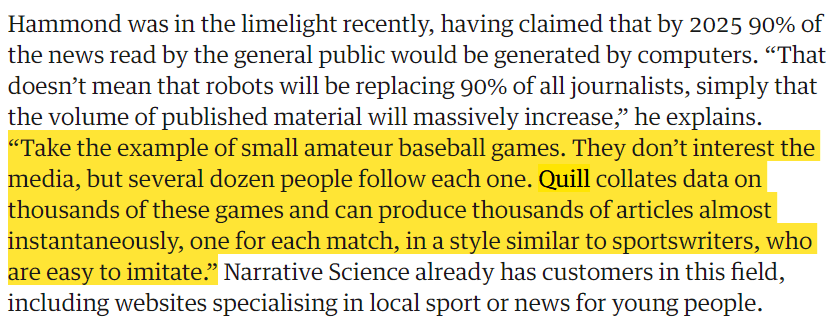
“Quill collates data on thousands of [small amateur baseball games] and can produce thousands of articles almost instantaneously, one for each match, in a style similar to sportswriters, who are easy to imitate.”
As early as 2015, Quill was writing well over 1 million words per day, according to MIT Technology Review.
Companies that have already opted into the service include Forbes, USAA, T. Rowe Price, and even U.S. intelligence agencies.
What’s the Cost?
Narrative Science’s pricing information for Quill isn’t available online, but through some previous research I did via Quora, I discovered price is based on story types (each story type is one interpretation of a particular dataset).
One story type could run you $70,000 per year, but it would potentially produce up to 100,000 stories.
3. Wordsmith by Automated Insights (The Associated Press)
Did you know The Associated Press, one of the world’s largest news conglomerates, uses natural language generation software to publish thousands of quarterly earnings articles?
They do, and the platform they use is Wordsmith by Automated Insights.
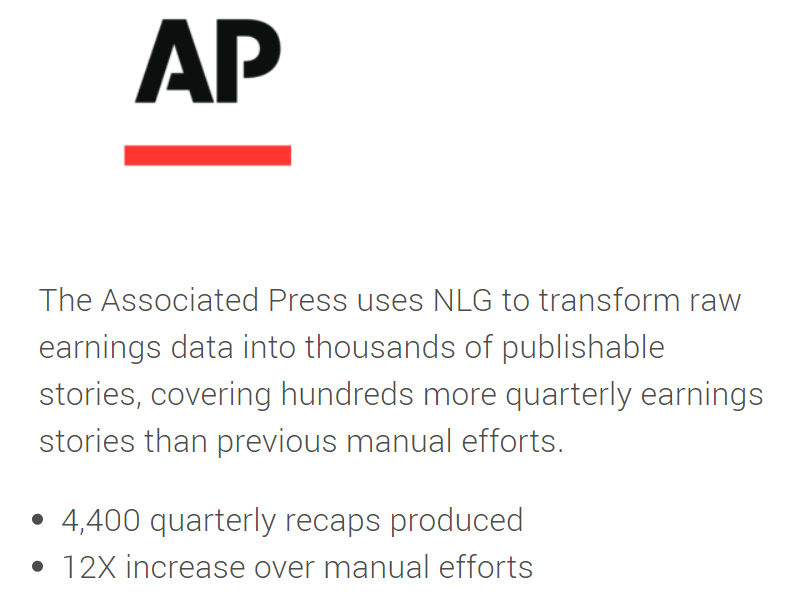
According to the Wordsmith product page:
“The Associated Press uses NLG to transform raw earnings data into thousands of publishable stories, covering hundreds more quarterly earnings stories than previous manual efforts.”
Eventually, along with financial reports, Wordsmith moved on to writing about college sports and minor league baseball.
There’s a big caveat that goes with Wordsmith’s success, though – it needs extensive instructions from humans to write in the correct style and tone.
First, the raw data – whether that means sports stats and scores or the quarterly earnings stats for a long list of businesses in a specific industry – needs to be collected and organized.
Before this data can be “fed” to Wordsmith, the platform first must understand how to interpret it and write a narrative about it. Thus, humans create templates and guidelines for the bot to follow (what Automated Insights calls “rule-based instructions”).
For instance, for The Associated Press, Wordsmith uses the AP Style Guide, among other templates, to write reports.
For a gist of how humans instruct Wordsmith, look at these examples of rules from TechEmergence:
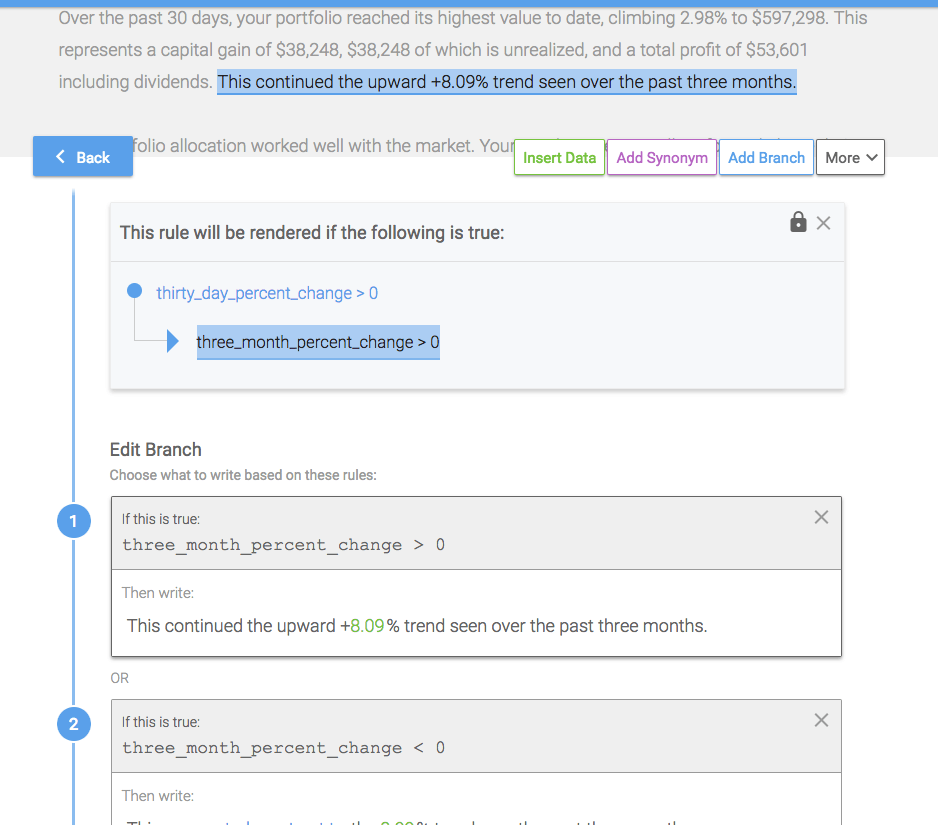
They also provide this GIF, which shows the beginning product (raw data) and the end product (an understandable, clear report):
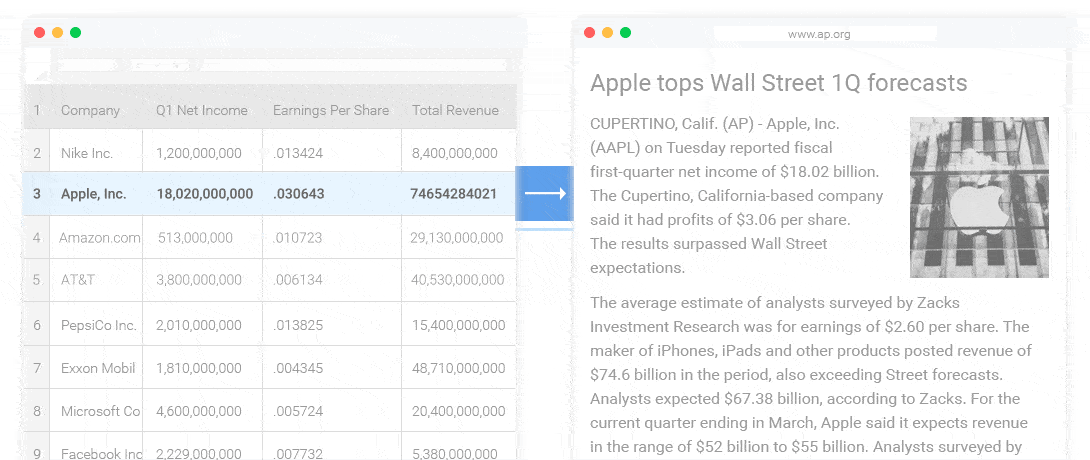
Unbelievably, Wordsmith can produce a report like the one above in mere seconds – as long as it has all the information, rules, and guidelines beforehand.
The NLG platform isn’t just for large businesses or corporate entities, however, nor is it just for finance and sports. According to Automated Insights, Wordsmith will work for virtually anyone, regardless of industry or company size.
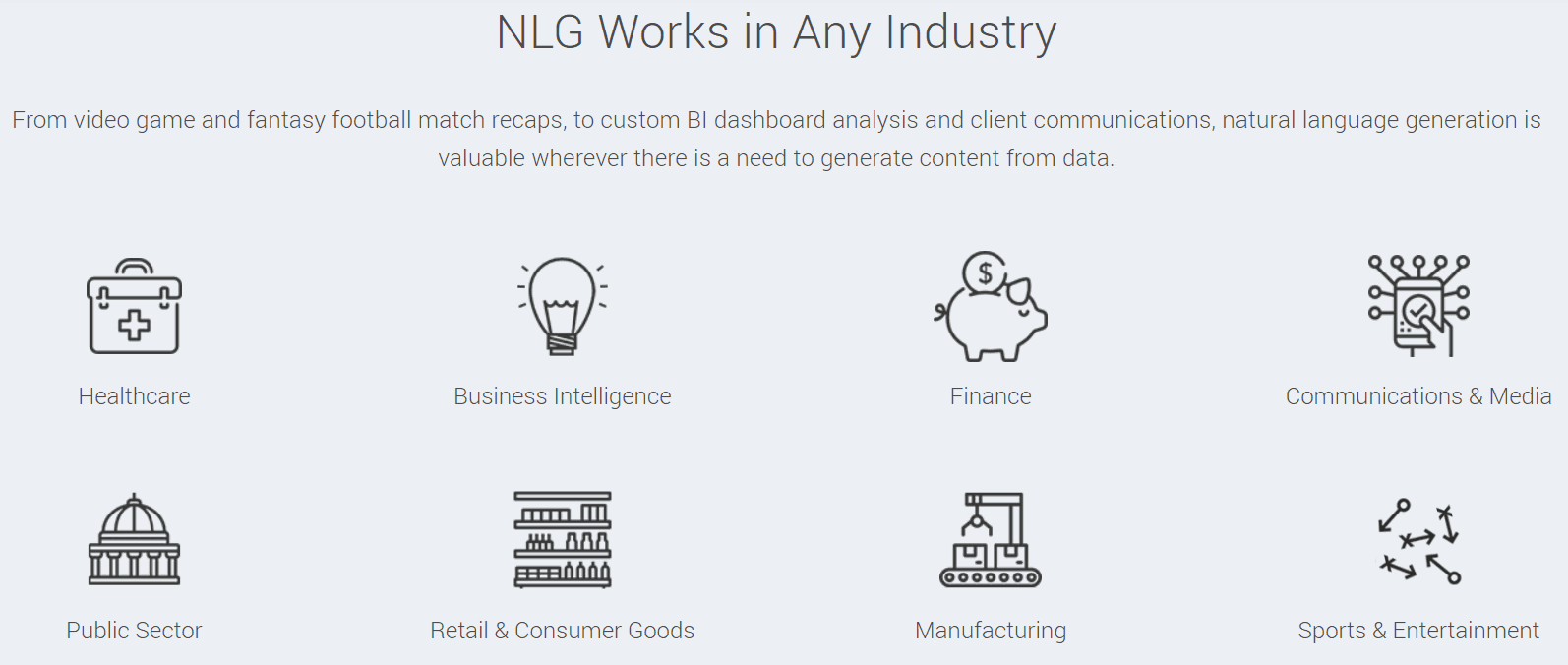
What’s the Cost?
Pricing information for Wordsmith isn’t available. However, you can request a personal demo of the platform to see how it might work for your business.
Worried? Don’t Be: 3 Reasons Human Writers Are Irreplaceable
If all this talk of AI-generated content is making you anxious about the future of your job as a content creator, relax.
Despite the growing sophistication of the technology, humans still have the upper hand.
1. Robots Can’t Replicate the Human Touch
Robots are robots.
They don’t have emotions, memories, or preferences, and they don’t love or hate anything.
This is exactly why human writers are irreplaceable. When writing is deeply human, it moves people much better than bare statements of facts.
We care about stories. To tell stories, you need a background of meaningful experiences.
Robots don’t have them.
If you want to see a great example of this in action, look at this comparison of a robot-written report versus the same report written by a human (via NPR).
Can you guess which one is the human’s work?
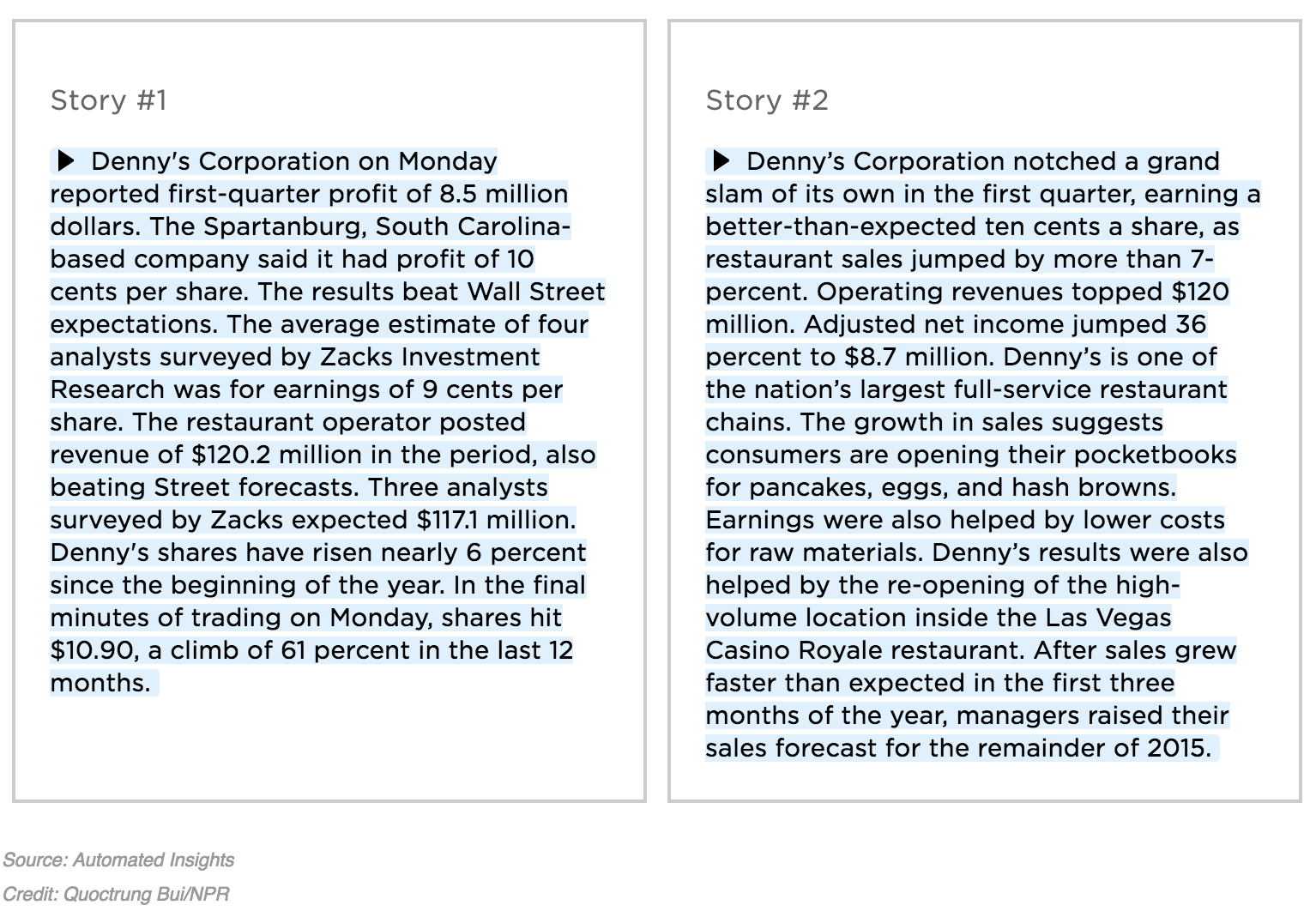
If you guessed Story #2, you’re correct. That story has some background, a bit of color, and turns of phrase that spark emotion. Like, for instance, the pun in the first sentence: “Denny’s Corporation notched a grand slam of its own in the first quarter…”
Compare that sentence to the bot’s opener: “Denny’s Corporation on Monday reported a first-quarter profit of 8.5 million dollars.”
It’s a decent sentence but lacks the flair of the human writer’s work.
Supposedly, that tone and style can be programmed into the platform, but it would require lengthy, meticulous tweaking and instructions from humans, first. (And probably lots of $$$.)
Sorry, robots, you just aren’t there, yet.
2. Robot-Generated Content Is Expensive
While some AI content generators are pretty slick, that’s not the norm.
What’s readily available to the public is not nearly at the level of what the big companies have access to.
For research purposes, I tried Articoolo, an accessible textual content generator, to see what would happen.
It’s not too expensive, and it’s available for the public to use. Unfortunately, that’s about all it has going for it.
I gave it a shot at creating content for the topic “content promotion.”
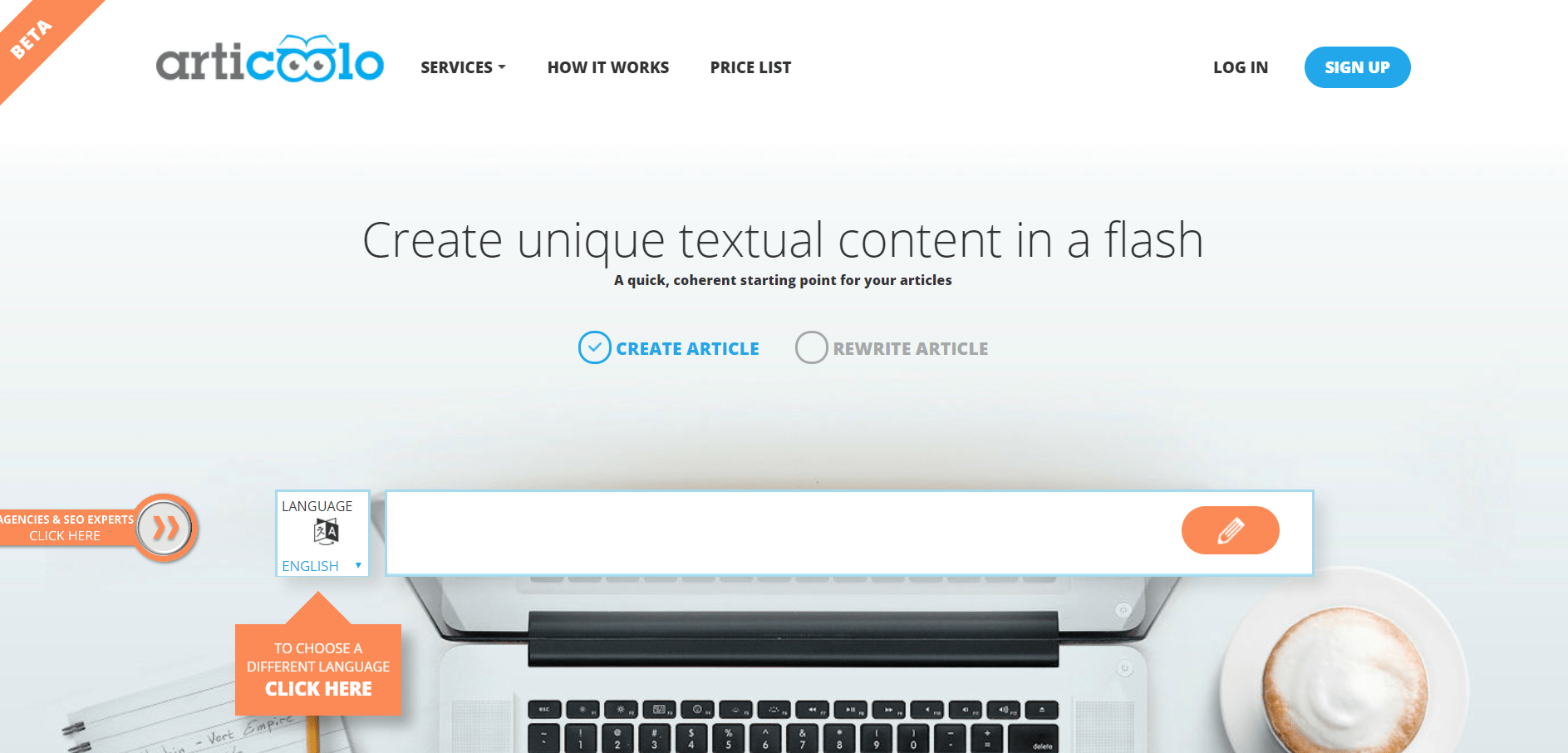
I entered my topic in the input box and hit the pencil button. After 2 minutes, the piece was ready, but I had to pay a total of $19 for the 10-article minimum (the site doesn’t let you purchase content on a piece-by-piece basis).
Here’s the opening sentence of that first result from Articoolo:
Content promotion is a subject in the promotion universe relating to publishing important messaging to a specific audience white papers will be an example of this.
Uhhh…
Not good.
Here’s the result of the second try, when I ran the same topic through the generator again:
The problem does not put in their ambition to embark on content marketing strategy, the issues come from 3 common areas: the intricacy of the content advertising ecosystem, too little expertise or understanding with content marketing, as well as the technical measurement issues related to how audience consumes content across different devices today.
Nope, nope, nope.
Apparently, you get what you pay for with AI-written content.
A measly $1.90 per content piece gets you gobbledygook that sounds exactly like a robot.
If you want stuff that’s actually publishable, you’ll have to pony up for the big guns (see: technology like Wordsmith and Quill).
3. AI Writers Are Not Relatable
Unless we’re talking about some humanoid cyborg scribe that time-traveled from the future, robot writers are not relatable or sympathetic like human writers.
For instance, look at influencers.
The worth of influencer marketing is expected to grow to $10 billion by 2020.
What makes their status so powerful?
Let’s boil it down to one aspect:
They’re humans who relate to other humans on a human level.
Lots of people know, like, and trust them, because they share themselves and connect with their followers on social media, blogs, and other outlets.
They relate to us in real, human ways. Thus, when they write a blog or create a post on Instagram, it can have an incredible impact – it can move people, literally.
Just one example:
@dirtbagdarling is an activist and influencer who regularly inspires and moves her followers to care about the causes she supports. This is a post she wrote about protecting public lands and the environment:
And this is just a sample of the comments and responses she receives from posts like this one:
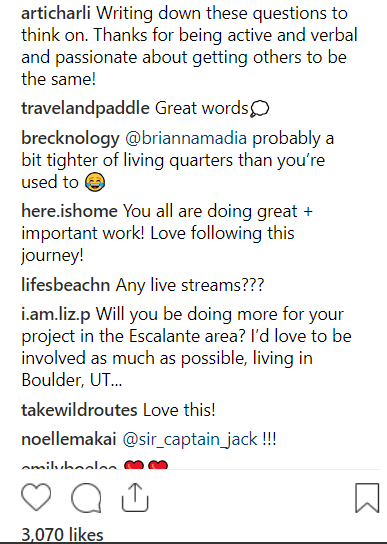
Human writers evoke emotional responses because they write with emotion. Even if we try to leave it out, it still can color our words.
Until robots have the power of independent cognition (and maybe not even then), AI content generators can’t replicate that.
Could a Robot Co-Worker Appear in Your Future?
So, could AI possibly replace human writers at some unspecified point in the coming years?
Well, maybe eventually. But it could take hundreds of years for technology to reach that point.
Right now, the possibility is greater that human writers will rely on robot helpers more and more to augment mundane tasks and cover a broader scope of information.
Look out for smarter tools, systems and AI in our industry: and work hard to maintain your place by being more creative, more human, and less robotic.
Future-proof your position in content by changing your mindset as an SEO professional.
No more “let me create more SEO content” – instead, think in terms of “how can I write with emotion, color, and creativity?”
Bottom line: You won’t be out of a job anytime soon.
Robots have a place, but it’s not to replace the creative human. It’s to help and assist them.
Your job? Be as human as you can, add creativity to your SEO writing, and you’ll be in-demand instead out of a job.
More Content Marketing Resources:
- AI in Content Marketing: 3 Frequently Asked Questions
- AI, Content & Search: 5 Macro Market Trends for Micro Marketing
- How AI & Dynamic Content Are Reinventing Email Marketing
Image Credits
Screenshots taken by author, September 2018

